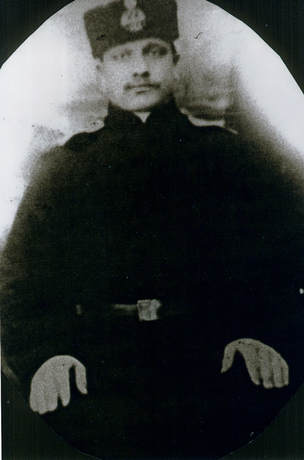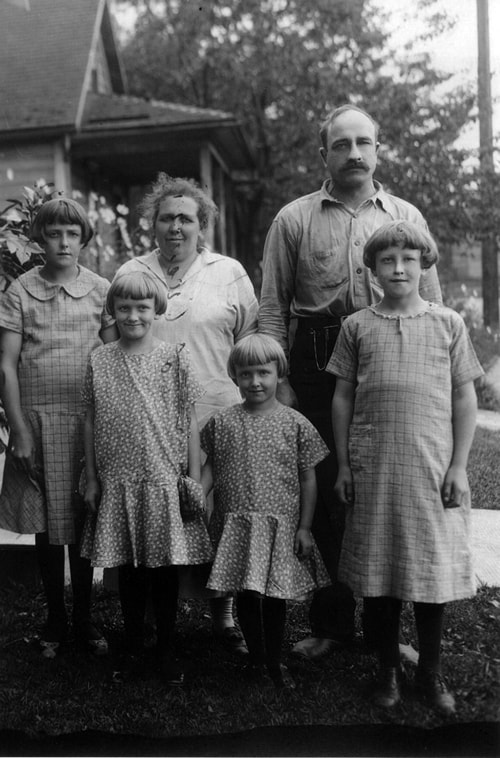People > Our People > Nicholas and Christina Weber
Nicholas and Christina Weber
Nicholas ("Nick") was born in Norka, Russia, on November 11, 1883, the son of Conrad and Catharina Weber. In 1907, Nicholas married Christina Weber, also born in Norka, on November 24, 1883.
Nicholas was conscripted into the Russian military to serve in the Russo-Japanese War. He served two years before gaining permission to leave to help support his family. Nicholas's brother Conrad immigrated to the United States in 1912. Nicholas stayed behind to help his parents manage their land. Nicholas could see dramatic changes coming to Russia, and the European continent would soon be at war. Nicholas sought passports for the entire family and arranged for them to emigrate from Russia.
In 1913, Nicholas and Christina departed from Norka and immigrated to the United States with his parents. Nicholas and Christina's sons, Phillip (born 1907) and John (born 1909), also journeyed to America. Christina gave birth to another son named Conrad, and Nicholas helped deliver the baby.
Nicholas was conscripted into the Russian military to serve in the Russo-Japanese War. He served two years before gaining permission to leave to help support his family. Nicholas's brother Conrad immigrated to the United States in 1912. Nicholas stayed behind to help his parents manage their land. Nicholas could see dramatic changes coming to Russia, and the European continent would soon be at war. Nicholas sought passports for the entire family and arranged for them to emigrate from Russia.
In 1913, Nicholas and Christina departed from Norka and immigrated to the United States with his parents. Nicholas and Christina's sons, Phillip (born 1907) and John (born 1909), also journeyed to America. Christina gave birth to another son named Conrad, and Nicholas helped deliver the baby.

Photograph of the Conrad and Catharina Weber family taken in Norka, Russia about 1909.
Front row from left to right: Nicholas "Nick" Weber holding his son Phillip Weber (born 1907), Christina Weber (nee Weber), Catharina Weber (nee Dörr), Conrad Weber, Elisabeth "Dimmi" Schleining (sister of Catharina Weber). Courtesy of Pat Hefflin.
Back row from left to right: Magdalena Weber, Conrad Weber (born 1893), Anna Elizabeth "Annalise" Weber, Katherine Weber. Courtesy of Pat Hefflin.
The trip was complicated because Christina suffered from cataracts, and the elder Conrad also had health problems. Due to their health problems, they were not allowed to board the ship. Nicholas worked tirelessly to overcome their problems and ensure that all the arrangements were made so they could board the ship. They saw a smaller immigrant ship that had begun to sink during the Atlantic crossing. The passengers from this ship were rescued, but the family remained fearful about the remainder of their ocean voyage. Family stories tell that Nicholas's sister, Catharina Maria, promised God that she would never dance again if their boat did not sink, and she honored that promise for the rest of her life.
The family sailed from Southhampton, England, on August 28th aboard the steamship Ascania of the Cunard Line and arrived in Quebec, Canada, on September 7, 1913. They traveled by train on the Grand Trunk Railroad from Quebec and entered the United States at Port Huron, Michigan, on September 8, 1913. From Port Huron, the family continued their journey by train to Portland, Oregon. The U.S. Border Crossing list states that Conrad and Catharina are going to the home of Conrad's daughter and son-in-law, Catherine Elizabeth (née Weber) and Heinrich Lehl, at 836 Mallory Ave. Another of Conrad's daughters from his first marriage, Anna Maria, married Philip Hohnstein and resided in Portland.
The family sailed from Southhampton, England, on August 28th aboard the steamship Ascania of the Cunard Line and arrived in Quebec, Canada, on September 7, 1913. They traveled by train on the Grand Trunk Railroad from Quebec and entered the United States at Port Huron, Michigan, on September 8, 1913. From Port Huron, the family continued their journey by train to Portland, Oregon. The U.S. Border Crossing list states that Conrad and Catharina are going to the home of Conrad's daughter and son-in-law, Catherine Elizabeth (née Weber) and Heinrich Lehl, at 836 Mallory Ave. Another of Conrad's daughters from his first marriage, Anna Maria, married Philip Hohnstein and resided in Portland.
Christina gave birth to their first daughter, Pauline, in Portland on January 28, 1914. Daughter Elizabeth followed on November 9, 1915, daughter Marie on February 17, 1919, and daughter Esther on February 14, 1921.
Nick and his brother Conrad worked for the railroad as carpenters and then at the shipyards during World War I. Both men were exempt from the draft because they had families. They would work a shift at Willamette Iron and Steel and then travel to the shipyard in North Portland with their old Ford so they could work another shift. After World War I, the shipyard jobs ended, and the railroads were no longer hiring. Nick and Conrad decided to purchase a garbage collection route for $1,500. The business included a wagon and two horses, which were kept in the backyard near the barn. The horses knew the homes of each customer and stopped without Nick or Conrad getting on the wagon. Garbage was taken to dump sites at NE 33rd Avenue at the intersection of Fremont Street and Interstate/Swan Island. Nick told the story of driving his horse and wagon team across the frozen Willamette River one freezing winter.
Family stories tell of Nick's fun-loving nature. He enjoyed a good party and a drink, but never on Sunday when he taught Sunday School classes. Nick collected over $2,000 for his church.
One day, Nick and his brother Conrad decided that they wanted to fly in an airplane and got a ride at the newly constructed Swan Island Airport.
Nick's children told how he helped many families and young boys who had no money and needed a job. One daughter said she never knew how many people were coming for dinner each night.
The family also enjoyed outings to the Jantzen Beach amusement park.
When the 1930 U.S. Census was taken (on April 7 and 8), the family lived at 760 Rodney Avenue. Nick's brother Conrad lived next door at 762 Rodney Avenue, and his mother also resided with Conrad's family until her death later in 1930.
Christina Weber died on February 25, 1938, and Nick Weber died on April 19, 1943. Both are buried at the Rose City Cemetery in Portland.
Family stories tell of Nick's fun-loving nature. He enjoyed a good party and a drink, but never on Sunday when he taught Sunday School classes. Nick collected over $2,000 for his church.
One day, Nick and his brother Conrad decided that they wanted to fly in an airplane and got a ride at the newly constructed Swan Island Airport.
Nick's children told how he helped many families and young boys who had no money and needed a job. One daughter said she never knew how many people were coming for dinner each night.
The family also enjoyed outings to the Jantzen Beach amusement park.
When the 1930 U.S. Census was taken (on April 7 and 8), the family lived at 760 Rodney Avenue. Nick's brother Conrad lived next door at 762 Rodney Avenue, and his mother also resided with Conrad's family until her death later in 1930.
Christina Weber died on February 25, 1938, and Nick Weber died on April 19, 1943. Both are buried at the Rose City Cemetery in Portland.
Sources
Information and photographs courtesy of Pat Hefflin.
Ancestry.com
Ancestry.com
Last updated October 26, 2023

